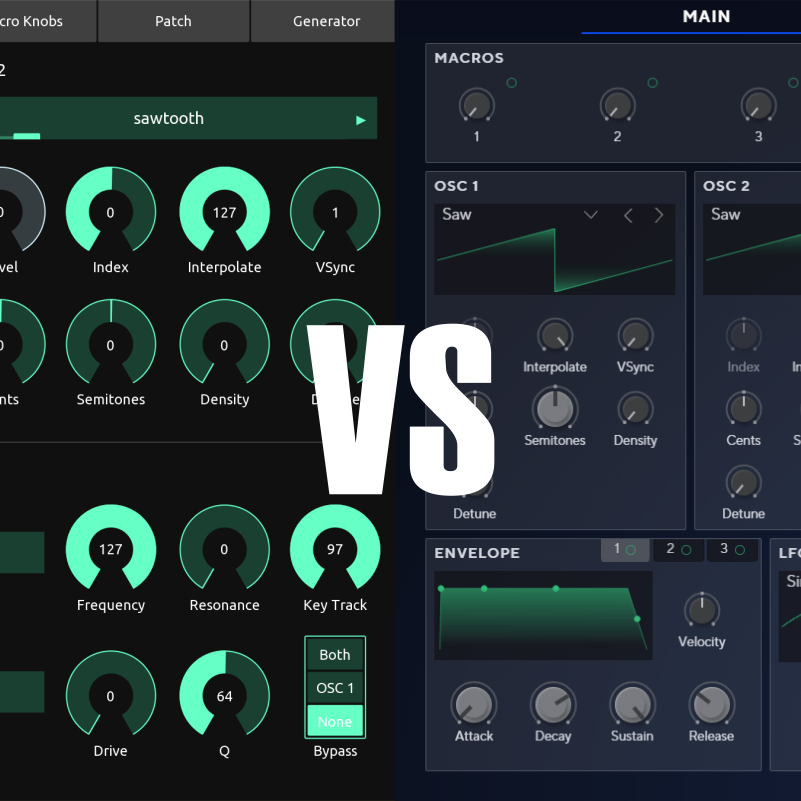Welcome to the second showdown between NC Editor vs, Components, this time we will have a closer look at the
Features
Basically, both editors do what they are supposed to do: They provide the ability to change any of the 300+ parameters of the Circuit synth engines. So far so good, so boring. Let's see what these editors are serving up beyond the basics.
Macro functions
In addition to basic parameter editing, NC Editor offers additional functions that make assigning macros quicker and easier. These include copy and paste or suggestions for common assignments. You can find out more about the macro functions in this blog post.
Components, on the other hand, sticks to plain home cooking: there is nothing beyond basic macro assignment.
Hardware Integration
NC Editor integrates the use of the two midi controllers Novation Launch Control XL and Akai Midimix. The surfaces of the two controllers are modeled in 2 additional layouts. The controllers provide access to the parameters on the Basic page, while all other parameters can be changed simultaneously via the user interface.
In addition to the advantage of haptic access, there are also additional functions such as "Undo", "Pickup" or 2 buttons for fine adjustment of values in steps of one.
The use of additional Midi hardware is not limited to these two controllers; with the help of this Midi CC documentation, other controllers (such as Arturia Beatstep) can also be programmed to edit parameters.
Components itself does not support the integration of hardware controllers. Parallel operation (e.g. with a virtual midi merger) is also not possible, as Components requires a direct connection to the circuit. And even if you trick Components by pretending to have a virtual midi connection with the name of your circuit: It also doesn't react to external midi CC inputs, so you won't see changes made by your controller (yes, I've tried it all)
Sound generator
Want to play sound roulette? The secret sauce is a sound generator: A nifty tool that randomly assigns values to parameters, creating a symphony of creativity and uniqueness.
Now, Components doesn't join this party. It keeps it classy but misses out on the thrill of randomness.
In NC Editor, however, this function is available on the additional "Generator" tab.
The generator lets you activate the randomness for each parameter individually (e.g. "Filter frequency") or in groups (e.g. "All filter parameters")
Feel a bit lazy but still want to go wild? Well, you can also randomly select the active parameters with a percentage (kind of random squares).
Moreover, there are additional functions that impact both the degree of deviation, ranging from subtle nuances to brute force, and the harmony of the sound.
OS support
Since Components is executed in the browser, it is theoretically available on every modern operating system. Unfortunately, the IOS security policy prevents mobile browsers from implementing the Web Midi interface, so Components does not work here. Novation also does not offer Components as an app, so the IOS world is currently left out.
NC Editor, on the other hand, is based on the touchOSC framework. TouchOSC is available on Windows, MacOS and Linux as well as for Android and IOS in the mobile world, so NC Editor also runs on IOS.
Patch and Pack Management
Ok, I don't like to admit it, but NC Editor can't really keep up here (it does have its niche where it shines, though)
Sample upload
NC Editor does not offer any functions for uploading samples to the circuit or opening samples from the file system. Everything that revolves around sample management must be done in Components, no ifs and buts.
Patch file upload
The same applies to the patch upload. Here, too, there is no option in NC Editor to load files from the local file system.
Pack management
Again, no option in the NC Editor. If you want to upload or download packs or access the Novation cloud where your packs are stored, you have to use Components.
On-device patch management
Both editors can copy and move patches on the device itself. However, the NC editor is faster and more direct. To move or copy patches with Components, the pack must first be downloaded from Circuit
and uploaded again after the changes have been made. Depending on how many samples and projects are contained in the pack, this can take a while.
In the NC Editor, patches can be moved back and forth without having to load the pack into the app first. This is much faster and also works between packs. So if you are in your creative flow and quickly need a lead sound from the other pack, you can simply copy it over and carry on. (I heard there are copying errors from time to time, but I'm sure the developer is already working on it ;-))
Patch Preview
Ok, this is just a small detail, but NC Editor has it: You can preview a patch first before you actually load or overwrite it. This way you can compare the sound you are currently editing with other presets and play it safe before you overwrite a preset.
Bottom Line
NC Editor offers a wide range of additional features that go beyond the simple editing of parameters. This makes the life of the patch programmer much easier and more flexible, and the work more creative.
However, there is no way around components when it comes to organizing packs and samples on your circuit or uploading patches from your local drive.

